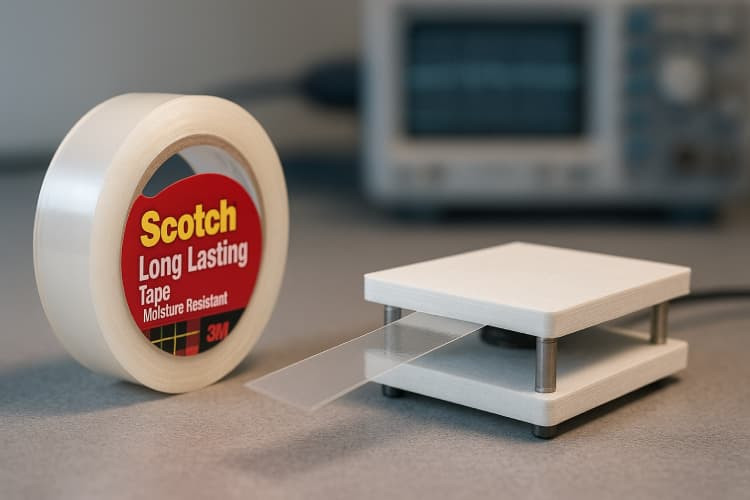Power from Scotch Tape: Energy Harvesting at 300Hz
Insights | 07-07-2025 | By Robin Mitchell

Key Takeaways:
- Researchers at the University of Alabama have developed a low-cost triboelectric nanogenerator (TENG) using store-bought Scotch tape and a vibrating plate.
- The system produces up to 53 mW of power at 40Hz and remains functional at frequencies as high as 300Hz—surpassing prior TENG designs.
- Demonstrated applications include self-powered wearable biosensors and acoustic sensors, highlighting its potential in flexible electronics and medical wearables.
- The device avoids direct skin contact, improving usability in long-term sensor deployments and mitigating performance loss due to sweat or irritation.
Wearable electronics have long promised to seamlessly integrate technology with the human body—but there's a catch. While flexible circuits and stretchable sensors continue to impress, powering these innovations remains a significant hurdle. Traditional batteries are bulky and rigid, and even the most promising flexible alternatives often fall short under real-world conditions. But what if the solution wasn’t hidden in an advanced lab—but instead in your stationery drawer? Researchers at the University of Alabama have uncovered a surprisingly effective method of energy harvesting using something as simple as store-bought Scotch tape.
So, how exactly does ordinary tape become a source of power, what makes this design so different from previous attempts, and could this low-cost approach pave the way for the next generation of self-powered wearables?
The Challenge with Wearable Electronics and Power Generation
The field of flexible electronics has taken impressive strides in recent years. From lab curiosities to prototype-level innovations, we now see flexible transistors, stretchable resistors, and paper-thin capacitors that can bend and twist with the human body. Material science has delivered in spectacular fashion, enabling designs that, not long ago, would have been pure science fiction. The ability to build circuits on substrates that move with the wearer opens the door to futuristic possibilities: smart clothing, biometric patches, and even unobtrusive medical implants.
But while the hardware might look the part, we're not quite ready to roll out mass-market, reliable wearable devices that can survive daily use. The honest truth? Flexible electronics are still in their awkward teenage years: full of potential, but not quite functional enough for the real world.
Let's be clear: the technology is brilliant in theory. But in practice, these systems are often fragile, suffer from degraded performance under strain, and don't yet meet the robust requirements of commercial products. You can design a beautiful, flexible circuit, but if it snaps after 100 cycles or loses accuracy when folded, it's not ready for prime time. And then there's the elephant in the room—power.
The Power Problem No One’s Cracked Yet
Power generation is arguably the biggest bottleneck in the wearable electronics space. Flexible power sources aren't just a challenge—they're a nightmare. You can make all the stretchable sensors you want, but if you can't feed them with power that's equally adaptable, your design is dead in the water.
Start with batteries. Traditional lithium-ion cells are rigid bricks—not exactly something you'd want sewn into your shirt. Developing flexible batteries requires chemistries that can tolerate bending without breaking, leaking, or—worst case—exploding. Spoiler alert: there aren't many. Researchers are experimenting with solid-state electrolytes, flexible packaging, and novel electrode materials, but most of this is still in the research phase. Reliability, safety, and capacity all take a hit when you start asking a battery to bend like a yoga instructor.
So maybe you pivot to energy harvesting. Let the body power the device. In theory, that sounds ideal: use motion, friction, or heat to keep things running. In practice? Triboelectric nanogenerators (TENGs), often hailed as the next big thing, tend to produce pitiful amounts of power—barely enough to light an LED, let alone run a sensor suite. You'd need a marathon runner constantly in motion just to charge a smart patch.
Why Harvesting Energy Isn’t the Easy Win It Sounds Like
What about solar? Flexible solar cells are definitely promising. They're lightweight, thin, and can conform to irregular surfaces. But even these have their issues. Organic photovoltaic materials degrade quickly, especially under sunlight (ironically). Their efficiency drops, and their output can be inconsistent. Long-term reliability is still a massive concern.
So, where does that leave us? With a lot of ambition and not enough current. The field of wearable tech is waiting for power innovation to catch up with the rest. Until we can develop power systems that are as flexible, durable, and efficient as the electronics they serve, we're going to keep running into the same wall.
Researchers Demonstrate Power Source From Store-Bought Scotch Tape for Future Flexible Electronics
Researchers at the University of Alabama have recently published a new paper in the American Chemical Society's Omega journal on the use of adhesive tape to generate electricity. The new study, led by Dr. Gang Wang and Dr. Moonhyung, demonstrates how store-bought tape can produce a triboelectric nanogenator (TENG), a device that converts mechanical energy into electricity. The team's new design utilises a combination of single-sided tape and a vibrating plate to generate electricity from the interaction between the polyproylene backing of the tape and the acrylic adhesive layer.
According to the study, the effectiveness of the generator stems from the atomic-level interaction between the tape's polypropylene surface and its acrylic adhesive layer. This interface creates localised electric fields driven by van der Waals forces, which allow for consistent triboelectric charge generation. The researchers observed that a thicker adhesive layer, found in long-lasting commercial tapes, resulted in narrower atomic gaps and subsequently higher energy output.
Design Tweaks That Delivered a Big Performance Leap
The new design has seen a significant improvement over the previous design, which utilised double-sided tape. The new design is able to rapidly connect and disconnect the layers of tape, resulting in a more efficient power generation. Additionally, the new design is able to operate at a higher frequency, up to 300Hz, compared to the previous design which operated at a frequency of less than 5Hz.
Peak power generation was achieved at 40Hz with a dual-layer configuration using Scotch long-lasting tape, producing up to 45mW. Introducing additional box-lock tape layers allowed the output to increase to 53mW. The system remained operational at frequencies as high as 300Hz, significantly extending its application range compared to earlier TENG prototypes which were limited to sub-10Hz environments.
From Lab Bench to Real-World Functionality
The researchers have demonstrated the capabilities of their new design by incorporating it into two sensors, an acoustic sensor for detecting sound waves and a self powered wearable biosensor for detecting movement. The team has also demonstrated that their device is able to power a laser pointer and 350 LED lights, with a maximum power output of 53 milliwats.
This capacity was demonstrated in a vibration-based energy harvester (VBEH) setup, where the tape assembly was mounted between 3D-printed plastic plates and tested using a modal shaker. The prototype successfully powered a 650 nm laser diode and over 350 LEDs, underlining its practical capability in small-scale, low-voltage wearable or portable systems. Signal measurements confirmed reliable performance across varying load resistances, including 2MΩ to 40MΩ ranges.
Low-Cost Build, High-Impact Potential
The new design is not only able to generate more power than previous designs, but it is also significantly cheaper. The use of single-sided tape eliminates the need for double-sided tape, which is more expensive. Additionally, the use of a vibrating plate to generate energy eliminates the need for a motor or other power source. This makes the new design a potential candidate for wearable devices that require a small amount of power.
Beyond cost-efficiency, the system design avoids direct human skin contact, addressing a known issue in wearable sensor degradation due to sweat or irritation. In a biosensor configuration, the generator was placed between fabric layers on the forearm, successfully detecting muscle and finger movements without loss of signal clarity. This feature enhances long-term usability in biomedical applications without compromising sensor fidelity.
Could Future Materials Be Hiding in Plain Sight?
What the team at the University of Alabama in Huntsville pulled off is nothing short of brilliant. Taking something as mundane and overlooked as store-bought adhesive tape and turning it into a functional energy harvester? That's not just clever—it's engineering at its finest. It's proof that good science doesn't always come wrapped in a million-dollar lab coat or stamped with the logo of a Fortune 500 company. Sometimes, it comes from simply asking the right questions about the things right in front of us.
Now, let's not get ahead of ourselves. This development won't be powering your smartphone, smartwatch, or smart fridge anytime soon. It's not the magic bullet for wearable energy harvesting, and the researchers know that. But that's beside the point. What they've done is stake a flag in a direction we'd be foolish not to explore further. And more importantly, it forces us to ask a bigger question: Are the materials of the future already sitting on our desks, hiding in plain sight?
If this story sounds familiar, it's because it should. Think back to graphene, now hailed as the miracle material of the 21st century. Its discovery didn't come from a billion-dollar particle accelerator or a vacuum chamber the size of a warehouse. It came from pencil graphite and a roll of Scotch tape (yes, more tape). A couple of researchers, armed with curiosity and a bit of patience, peeled back the layers of ordinary graphite to reveal a supermaterial that's rewriting the rules of conductivity, strength, and flexibility.
We may well be looking at a similar inflexion point. The next revolutionary semiconductor material might not be buried in a rare-earth mine or grown in a climate-controlled cleanroom—it might be lurking in your garage, under your sink, or in your toolbox. It could be that the key to reliable, flexible power isn't some exotic compound with a 12-syllable name, but rather a household item we've all ignored because it seemed too... normal.
And that's what makes this space so exciting. Flexible electronics are still finding their footing, but every discovery like this tape-based TENG gives the field a push forward. It's a reminder that the future of tech won't always come with flashing lights and grand announcements. Sometimes, it'll arrive quietly, in the form of a material you've walked past a hundred times and never given a second thought.
As an engineer, I can't help but be energised by where this might lead us. The boundaries between science fiction and practical engineering are getting blurrier by the day, and flexible electronics are smack in the middle of that transformation. The materials of tomorrow might be right under our noses today—we just need the right minds to notice.
And frankly, I can't wait to see who notices next.

